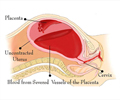There are numerous instances in India where women lose their lives during pregnancy, delivery or due to post-partum complications. The country has remained silent
There are numerous instances in India where women lose their lives during pregnancy, delivery or due to post-partum complications. The country has remained silent on these cases of maternal mortality- until now.
A powerful new tool that analyses the underlying medical and social reasons behind maternal mortality is being used by health experts, policymakers and communities to save women's lives.The Maternal and Perinatal Death Inquiry and Response, the MAPEDIR, innovation extends across select districts in Rajasthan, Madhya Pradesh, West Bengal, Jharkhand, Orissa and Bihar providing an ongoing, systematic collection of data to reconstruct and analyze the cases of 1,600 women - the highest number of audited maternal death in the world.
MAPEDIR empowers communities by demystifying maternal mortality. The accumulated evidence can help communities understand the root causes behind these deaths so they can take effective, local action and advocate for improved services to prevent future deaths. In addition, MAPEDIR informs health officials about the challenges local women face in accessing reproductive health care.
"The tragic reality is that too often maternal deaths are not visible. They don't leave any trace behind, and they are not accounted for," Chris Hirabayashi, UNICEF India Deputy Director of Programmes, said at a meeting bringing together health officials from all six states. "UNICEF is committed to continue working with the National Rural Health Mission to promote surveillance as a key strategy to lower maternal and child mortality."
The Indian Government estimates that 301 women die annually for every 100,000 live births. In some states the maternal mortality ratio is even higher - 358 in Orissa, 371 in Bihar and 379 in MP. Since many deaths happen in the anonymity of women's homes or on the way to seek help at a medical facility, they often go unrecorded. An estimated 80,000 pregnant women or new mothers die each year in India often from preventable causes including hemorrhage, eclampsia, sepsis and anemia.
For India to achieve the Millennium Development Goal of reducing maternal mortality by three quarters by 2015, social and economic factors like the low status of women in communities, the poor understanding of families on when to seek care, a lack of transport, poor roads, the cost of seeking care, multiple referrals to different health facilities and a delay in life-saving measures in rural areas need to be addressed.
Advertisement
"Unless we know the main reasons for maternal death we cannot take effective measures to tackle them. The traditional system did not deal with the issues adequately," said Dr S.P. Yadav, Director of Medical and Health Services in Rajasthan. "Now using MAPEDIR, we can know if they are due to delays in decision making at household level or lack of transport or delay at the facility or a cumulative of all three." The team, made up of state government health and nutrition officials and NGO members, headed by a member of the local village council or Panchayati Raj Institution, conducts interviews with surviving family members at community-level. Technical support is being provided by UNICEF with funding from the United Kingdom's Department of International Development.
Advertisement
By raising awareness of the tragedy of maternal mortality, communities and policy makers are motivated to take action to improve health services, such as a referral transport scheme in West Bengal and a community-based obstetric helpline in Rajasthan that were put in place following the findings. "These are major innovations to increase the value of women's lives," said Marzio Babille, chief of UNICEF India's Health section.
MAPEDIR follows a six step process:
Sensitizing communities on maternal and perinatal health issues, including birth preparedness and complication readiness.
Reporting and investigating maternal deaths.
Interviewing all families with a maternal deaths to determine the biological and social causes.
Analyzing and interpreting the data.
Sharing the finding with communities to develop appropriate, high-impact, local interventions.
Monitoring the interventions with ongoing maternal inquiries and developing new evidence-based interventions as needed.
Source-ANI
TAN











